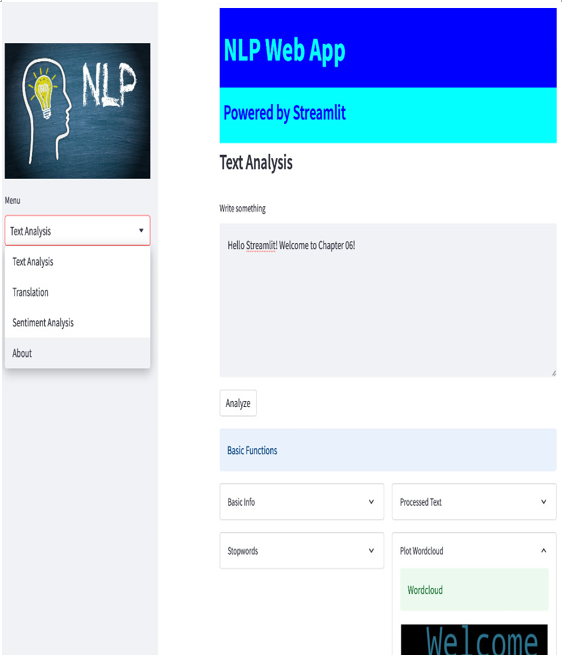Deep-diving into NLP techniques
Our web application already has a well-structured skeleton that can be applied to future applications, which is very important. Additionally, our app offers a high level of customization, such as the ability to set a title and icon in the browser. We have also completed the Text Analysis and About sections of the menu. To see the current status of our developments, please refer to Figure 6.1.

Figure 6.1: Starting point of Chapter 6
When we click on Translation or Sentiment Analysis, we just get, in the main part of our web app, a subheading reminding us of the section we are in, and nothing else. So, it’s now time to code these two functions.
Before delving into the code, let’s try to understand exactly what translation and sentiment analysis are.
What is translation?
Translation in NLP is the task of automatically converting text or speech from one language to another. It helps break down language barriers and facilitates global communication. Advances in machine translation (MT) have revolutionized the field, with statistical machine translation (SMT) and neural machine translation (NMT) playing key roles. NMT, powered by deep learning and transformer models, captures context and generates more fluent translations. Challenges include preserving style, handling idioms, and adapting to specific domains. The future holds promise for further advancements in accurate and culturally sensitive translation systems, promoting cross-cultural understanding.
What is sentiment analysis?
Sentiment analysis, or opinion mining, is a task in NLP that aims to extract emotions or subjective information from text. It involves classifying text into positive, negative, or neutral sentiments. Traditional approaches relied on rules and lexicons, while machine learning techniques, including deep learning and pre-trained models such as BERT, have revolutionized sentiment analysis. Challenges include fine-grained analysis and aspect-based sentiment. The future holds advancements in accuracy, language coverage, and ethical considerations. Sentiment analysis provides valuable insights for decision-making in various applications.
Sentiment analysis provides insights into opinions and emotions expressed in text. It helps businesses understand customer feedback, market trends, and public sentiment. By analyzing sentiment, companies can improve products, tailor marketing strategies, and make data-driven decisions. Sentiment analysis also finds applications in social media monitoring, reputation management, and public opinion analysis.
Together, translation and sentiment analysis offer enhanced customer understanding. Businesses can analyze sentiment across languages, gaining insights from multilingual sources. This integration enables comprehensive views of customer sentiment across markets, aiding in identifying patterns, areas for improvement, and cultural context adaptation.
These tools also contribute to social and political analysis. By analyzing sentiment across languages, researchers and policymakers gain a broader understanding of public sentiment on various topics, policies, and social movements. This facilitates effective communication and informed decision-making.
Let’s begin by checking out the Translation option on our menu.
